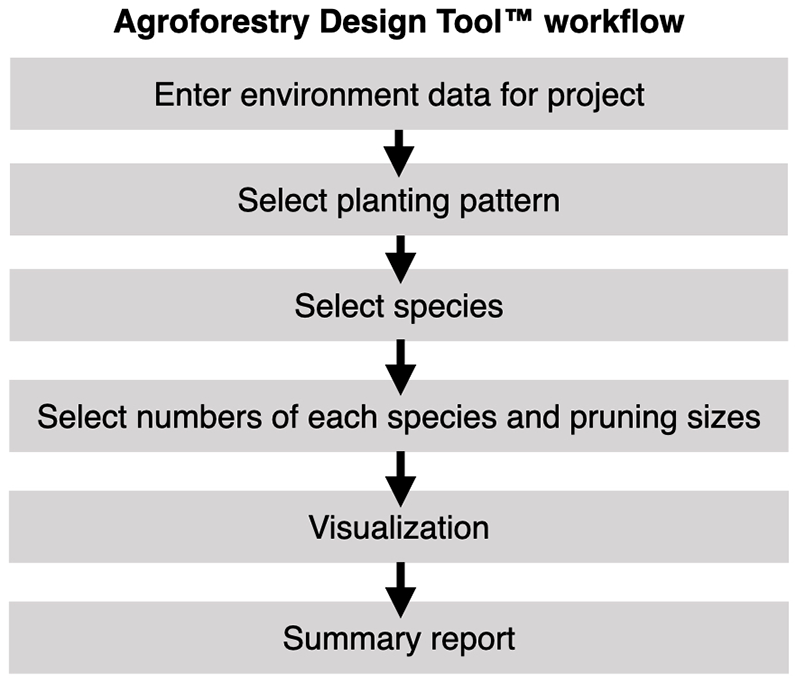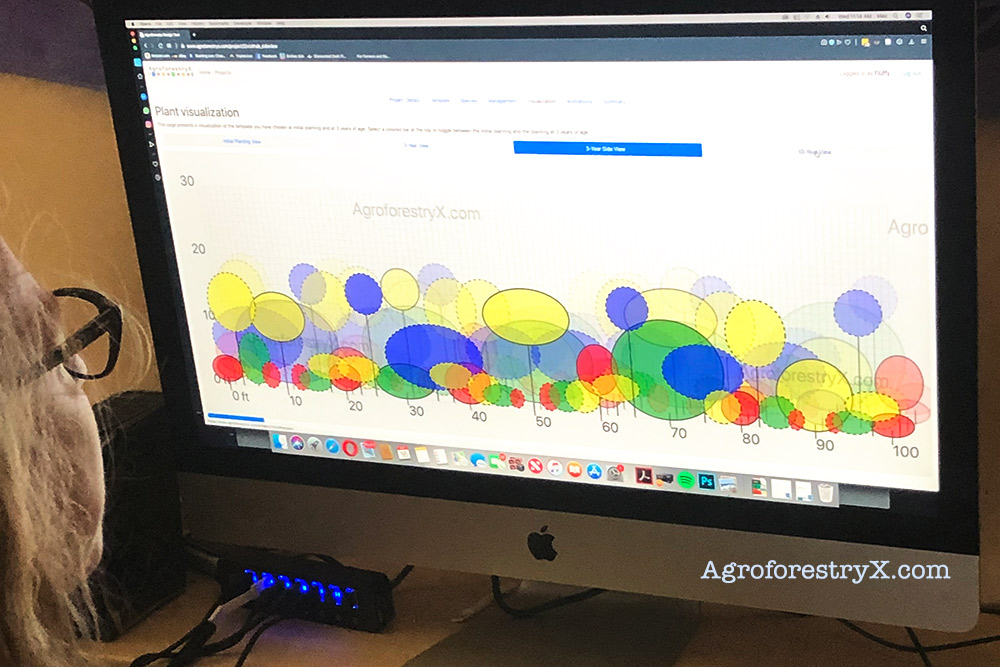Agroforestry Design Tool™ assists you in transforming regenerative agroforestry vision into design.

There are no recipes for agroforestry. Each agroforestry project is tailored to site conditions, goals of the project, and personal preferences. This tool provides guidance in designing multistory agroforests which can be applied to food and/or timber production, native habitat restoration, and individual user goals. Multistory agroforests have the potential to regenerate degraded soils, restore biodiversity, sequester carbon, and provide many other ecosystem services while producing abundantly.
The Agroforestry Design Tool helps the user in selecting species, creating a geometric planting layout, and in visualizing how the planting will look over time. The Tool should be seen as assisting the user in the design process, but it is not a replacement for the expertise of those familiar with local environmental and economic conditions. Expert consultation should always be sought before implementation.
What this tool does
The Agroforestry Design Tool™ (ADT) helps the user in selecting species and a geometric planting pattern, and in visualizing how the planting will look over time. The Tool begins with your environmental data for a specific project, followed by guidance for selecting a planting configuration and a suite of species. The Tool can assist you in following the species diversity requirements of the U.S. Department of Agriculture Natural Resources Conservation Service's “PI For/AgFor Technical Note 11—Mixed Agroforest Specification” or a regenerative agroforestry standard. Once species are selected, you have the option of selecting the number of each species and changing the pruning sizes of managed crops. The next step presents visualizations of the planting configuration you’ve chosen, followed by the option to export your project plan to your device as a pdf file.

Species selection | Spacing | Visualization
The Agroforestry Design Tool is based upon positioning plant species that occupy different forest layers in orientation to each other in time and space (short-, medium-, and long-term crops). The arrangement of crop species in both time and space leads to an agroforest designed to mimic a natural forest ecosystem in both structure and function. The layer each species occupies is determined by light needs and niche occupied in their respective ecosystems of origin. The layers are color-coded to assist the user in interpreting their planting configuration. The color system we use for the different layers is illustrated in the figure below, with the approximate relative heights of the species (if allowed to grow naturally without pruning) given in the table.

| Stratum (layer height class) | Icon color | Light requirements | Long-term species (4+ years) | Medium-term species (0–4 years) | Short-term species (0–2 years) |
|---|---|---|---|---|---|
| Emergent | Full sun | 40+ ft | 12+ ft | not illustrated | |
| High | ≈80% sunlight | ≈18-40 ft | ≈6–12 ft | not illustrated | |
| Medium | ≈60% sunlight | ≈10-20 ft | ≈4–8 ft | not illustrated | |
| Low | ≈40% sunlight | ≈2-12 ft | ≈2–6 ft | not illustrated | |
| Ground | not illustrated | 20-80% depending on location relative to trees | — | — | — |
Limitations
The Tool should be seen as assisting the user in the design process, but it is not a replacement for the expertise and knowledge of local environmental and economic conditions. The Tool has a number of limitations to be aware of:
- The species database is for the U.S.-affiliated Pacific Islands (although many of the species are found throughout the tropics).
- This tool is not meant as a replacement for traditional or indigenous agroforestry knowledge, but only as a planning and learning tool.
- The Tool assumes that the site has been prepared and is in good condition for planting.
- The planting configurations are given in the form of a 100 ft x 100 ft (30 m x 30 m) pattern, which will need to be adapted for the specific shape and size of the site by the user.
- Suggested planting configurations assume the user is starting with an open field, although the user can adapt their chosen pattern to existing vegetation manually after downloading the design.
- The Tool does not consider integration of livestock.
- The Tool currently operates in imperial units (feet, inches), although environmental data for the site may be entered in metric units.

About Us
The lead designers are Craig Elevitch and Neil Logan with technical support provided by Sophia Bowart. Erin Moon was responsible for application engineering. Our team has extensive experience in agroforestry design and implementation in widely varying environments of Hawaii, the Pacific Islands, and the Americas. As growers became more interested in implementing agroforestry as a means to regenerate productive landscapes, we saw the need to assist them with species selection, spacing, and management decisions for multistory agroforestry. In addition to our lifelong passion for growing trees, we happen to have backgrounds in systems engineering and computer programming. Out of this experience comes this tool for re-establishing diverse and productive agroforestry systems for regenerating degraded landscapes.
Agroforestry Design Tool authors and citations
This work is a collaboration of Permanent Agriculture Resources and Forest Agriculture Research Management Center (FARM Center). The tool is provided free-of-charge through the year 2023 with assistance from a U.S. Department of Agriculture Natural Resources Conservation Service Conservation Innovation Grant. Please acknowledge AgroforestryX.com in your work products that utilize language, concepts, and other material presented or generated by this tool. Please cite the tool as: Elevitch, C.R., and N. Logan. 2019–2021. Agroforestry Design Tool™—AgroforestryX.com. Hawaii. http://agroforestryx.com.
Acknowledgements
There are many who had a hand in conceiving and creating this tool. We thank Bill Sethares, Rick Johnson, David Rodman, and Donna Marlatt for initial development advice. Those whose friendship and brilliant agroforestry work has greatly influenced our perspectives include Ernst Götsch, Henrique and Victoria Souza, Jose Fernando Rebello, Gustavo Martins, Felipe Pasini, and Dayana Andrade. Thank you to the dedicated NRCS staff who worked closely with us to make this tool a reality. JB Friday collaborated on the project and gave detailed feedback on the usefulness of the tool. We are hugely indebted to reviewers who shared their thoughtful advice and corrections: Ngaire Gilmour, Niki Mazaroli, Kate MacFarland, Gustavo Martins, Roots, Kiernan Brtalik, David Theodoropoulos, Robin Van Loon, Bob Harris and Jen Snyder, David Griffin, Susan Leopold, and Eleanor Bingham Miller. Thank you to our agroforestry colleagues throughout the Pacific, who have inspired us toward a life-long journey to learn about the time-tested indigenous roots of Pacific Island agroforestry: Nat Tuivavalagi, Randy Thaman, M. Kalani Souza, Papali'i Failautusi Avegalio, Kap Tafiti, Arnold Route, Marilyn Salas, Ansito Walter, Lolita Ragus, and Mark Kostka, among so many others.
Disclaimer
Reasonable efforts have been made to present useful information. The authors, editors, and publishers cannot assume responsibility for the validity of all materials or for the consequences of their use. The authors, editors, publishers, and sponsors shall have neither liability nor responsibility to any person or entity with respect to any loss or damage caused, or alleged to have been caused, directly or indirectly, by the information contained in this publication. Expert consultation should be sought prior to investment.